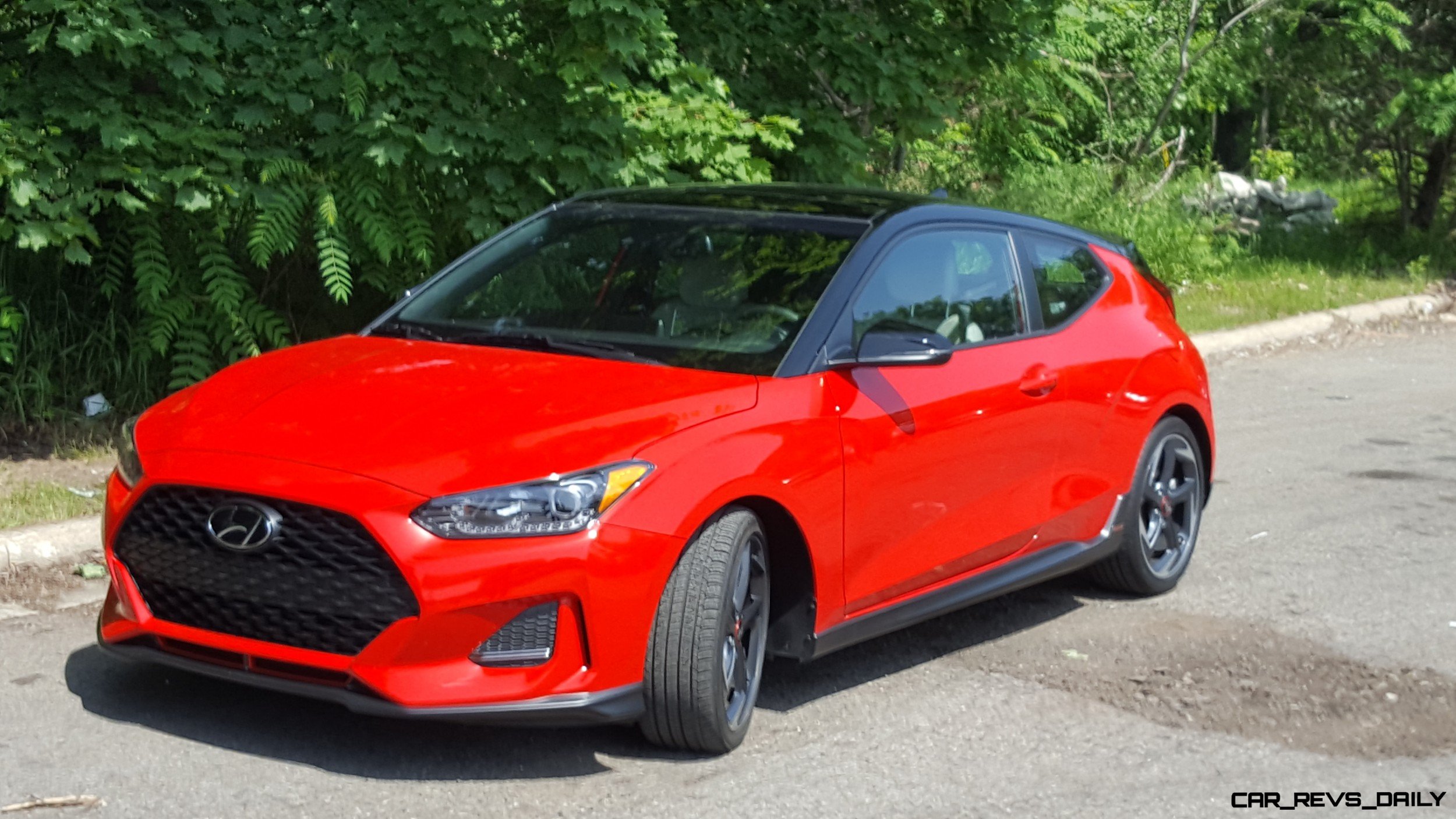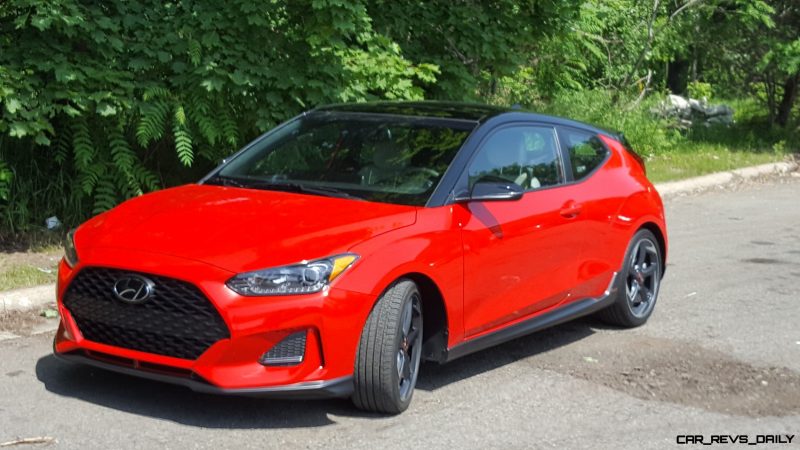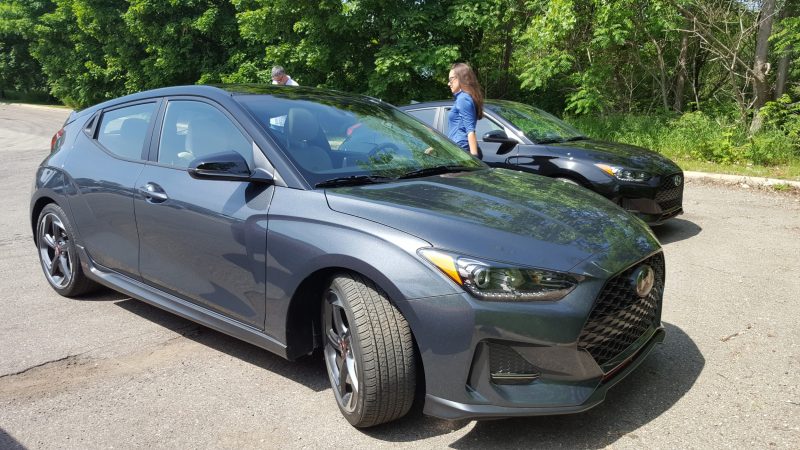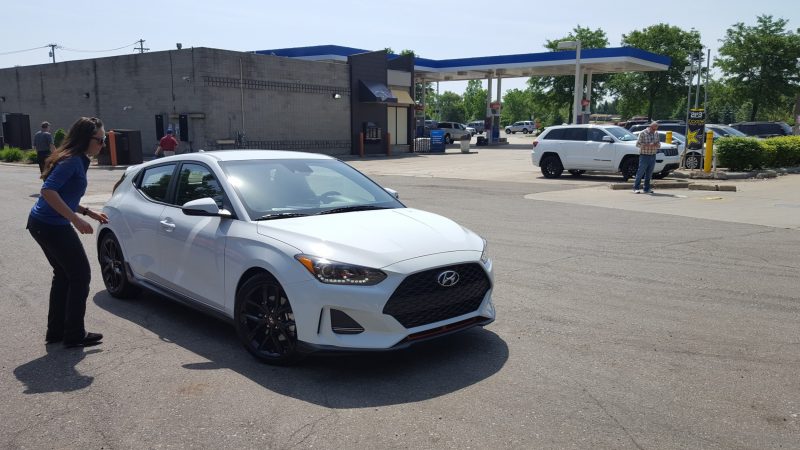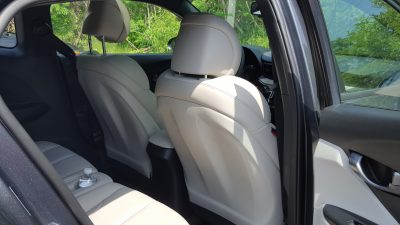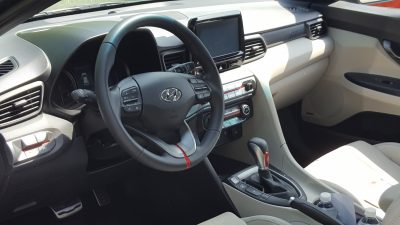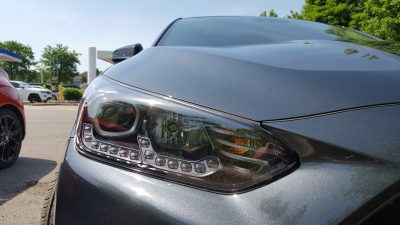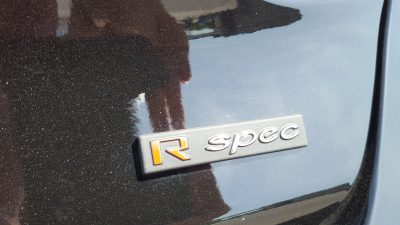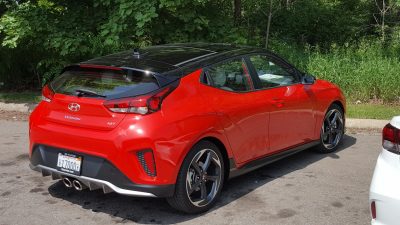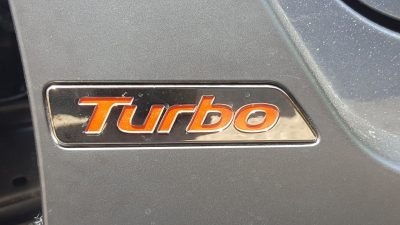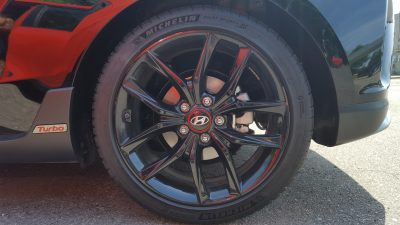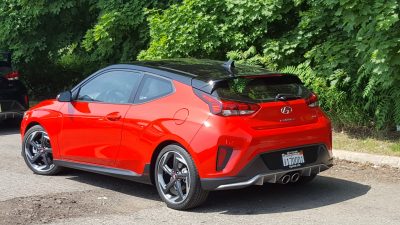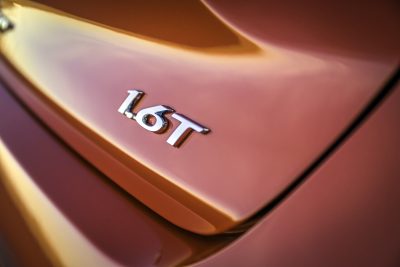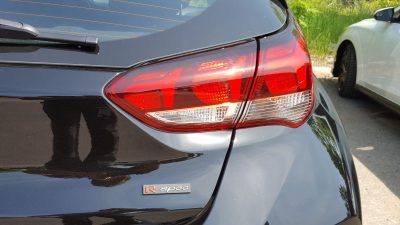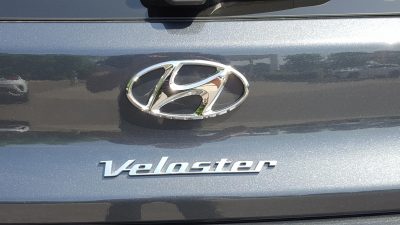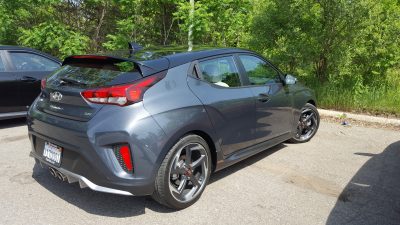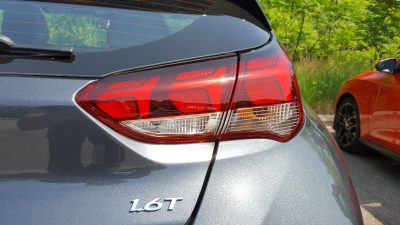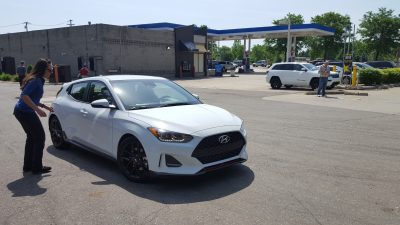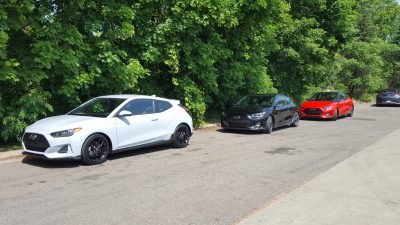When the first generation Veloster arrived on the scene several years ago, it was a symbol of Hyundai’s early foray into revamping the image of its overall product lineup.
While the first generation Veloster did have a few rough edges and flaws underneath its slick skin, it nevertheless served as a compelling “reverse halo” offering that did bring in more young buyers.
With the arrival of the second generation Veloster, Hyundai has made the usual assortment of updates and revisions to help the Veloster refine and hone its youthful swagger.
Can this updated Veloster stand out in a segment that has not only been under attack by crossover entries? but also against segment benchmarks like the Volkswagen Golf?
To find out, we had the chance to spend some quality time with the 2019 Veloster in Metro Detroit to see how it fared as a quirky alternative to segment benchmarks. The exterior styling still retains the squat tapered lines that defined the old Veloster, but here, the look is much more unified with the cascading front grille and Elantra GT-esque front headlights bringing some much needed polish and enhanced assertiveness to the Veloster’s face.
The side profile showcases the quirky 3-door layout that served as a calling card for the original Veloster. Like before, it is still a love it or hate it affair, with Hyundai claiming that it wanted to maintain a coupe like profile, but without the sacrifice in practicality that conventional coupes often make, thus the use of the passenger side mounted third door. The rear fascia keeps the old car’s basic formula (including the centrally mounted exhaust tips,) but Hyundai designers have also sharpened the taillights for a decidedly more modern appearance.
R-Spec models spice up the look even further thanks to their slick wheels, as well as minor trim alterations that amp up the car’s sinister quality even further. With offerings like the Civic Hatchback and the venerable Volkswagen Golf out on the road, we are glad to see a hot hatchback that at long last, brings some much needed sizzle to this key segment.
While the Veloster will never have the balanced blend of poise and elegance that has defined the Volkswagen Golf for the bulk of its existence, it’s much more aggressive and youthful, which should please young millennials that want an offering that stands out versus being lost in a sea of mundane compact car offerings that too often miss the mark in their sporty intentions.
The interior of the 2019 Veloster is a noticeable and welcome improvement over its predecessor. Yes, hard plastics are still abundant through out the cabin, but it features a more upscale grain, and benefits from better fit and finish. The Veloster offers 20 cubic feet of cargo room, and while it is a tight fit for larger bags, it does actually surpass several small CUV offerings which is an impressive feat. the rear quarters also house more headroom, but unfortunately, the lack of rear visibility and prominent blind spots still dog the Veloster, especially in tight city driving, where passing and parking maneuvers require drivers to exert patience and maximum trust in the rear backup camera.
Thankfully the rest of the cabin makes up for these glaring omissions by offering a compelling environment that is leagues ahead of the old car. Our Turbo Ultimate tester featured simple white on black gauges, and Hyundai’s familiar and efficient infotainment system still retains its key role in luring in tech savvy buyers. The core of the cabin’s layout is restrained, but also has a straightforward layout with a driver oriented setup.
The 2019 Veloster has five distinct trim levels, and each one is identified by different upholstery appointments, as well as welcome splashes of color on the seats and dashboard. While our range topping tester made a good first impression during our time with it, ultimately it is the mid-range R-Spec model that we would put in our garage. This is due to its slick B&M tuned six speed shifter, as well as several performance inspired touches that are splashed throughout the cabin. R-Spec cars are manual only, but look for that to not stop enthusiasts, or even value minded buyers from adding one into their driveway.
Performance for the 2019 Hyundai Veloster comes from a pair of four cylinder engines with a 2.0 liter naturally aspirated engine serving as the base offering. While it does make 15 more horsepower and 12 more lb-ft than the old 1.6 liter for a grand total of 147 horsepower and 132 lb-ft of torque respectively, it is still a mostly noisy affair with little go to show for it. On the flip side, styling and chassis tuning are nearly identical to the Turbo’s and at $19,385 it includes forward collision warning, automated emergency braking, cruise control, lane keep assist, 17-inch wheels, automatic headlights, and the 7.0 inch touchscreen infotainment system with Apple CarPlay and Android Auto compatibility.
On the other end of the spectrum, the Turbo lineup begins only $150 above the 2.0 liter Premium model which is a small example of the superior value wielded by the Turbo. For instance, the $23,785 R-Spec model is not only the most wallet friendly way into the Turbo’s good graces, but brings a lot of performance goodies into the equation. Meanwhile, the simply named Turbo starts at $$26,285 and can be equipped with both the six speed manual and the 7-speed dual-clutch automatic. Turbo Ultimates like our tester get more equipment, but a higher $27,535 base price to go with it.
All Turbo models feature beefier anti-roll bars, and their effect on reducing body roll was noticed during our time with the Veloster. Handling was poised and solid with our tester feeling more athletic and planted than its predecessor. Alot of this falls on the all new multi-link rear suspension which helped deliver excellent chassis control on curvy roads, while also doing a reasonable job filtering out bumps and ruts. Our lone gripe was with the steering, which did a good job communicating to the driver, but felt a bit too heavy in sport mode for average commuting. If the Veloster visits a track, this extra heft is actually beneficial, but not so much on long winding roads.
Performance is carried over from the old model, with a 1.6 liter turbocharged four banger producing 201 horsepower. We have encountered this engine in several other Hyundai and Kia offerings, and like always, we admire its spunky demeanor as well as the commendable levels of acceleration that the engine produces. However, the turbo is best served with the six speed manual, versus the 7-speed in our tester. Manual shift inputs were slow with either the paddles or the shifter, and we noticed a somewhat unsettling tendency to hold the revs above 4,000 RPM during gentle deceleration in Sport mode. We also caught the computers sleeping on the job on a few separate occasions, especially in more spirited driving.
When left to its own devices, the transmission tended to shift just short of the red line to allow the engine to take full advantage of the gobs of torque in the lower and middle ranges of the power band. While it is not the most overtly sporty feeling on the planet, it is reasonably effective, and certainly gives the Veloster a raw enjoyable edge that is missing from rivals like the Honda Civic Si and the Volkswagen GTI.
All Turbos also include a digitally enhanced engine note, with the volume depending on which of the three driving modes (Normal, Sport, Smart) you choose. We cycled through all three to try and find a distinct sound difference, but we were unable to do so. Hopefully when we have the chance to have a Veloster here at the Michigan office, we will be able to have our resident audiophile Emily deliver final judgement on its perceived effectiveness. In the meantime, buyers that prefer to hear the engine in all of its natural glory, can turn off the feature completely by accessing the infotainment system.
If you can learn to live with the Veloster’s quirks and funky door layout, it proves to be a compelling deal especially when compared to others in its segment. The Turbo covers the performance spectrum, and in R-Spec guise, is only $1625 more than the equally competent, but incredibly cramped Fiesta ST. It also undercuts the Honda Civic Si by as much as $1410, with the GTI giving up nearly $3500 to a loaded Ultimate model. With all of this untapped value and a new injection of swagger the 2019 Hyundai Veloster Turbo aims to slice a compelling chunk of the compact car market for itself, and we look forward to seeing what else is in store with the upcoming Hyundai Veloster N hot hatch.
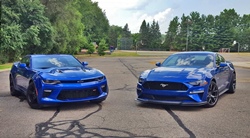
Carl Malek has been an automotive journalist for over 10 years. First starting out as a freelance photographer before making the transition to writing during college, his work has appeared on numerous automotive forums as well as websites such as Autoshopper.com.
Carl is also a big fan of British vehicles with the bulk of his devotion going to the Morgan Motor Company as well as offerings from Lotus, MG, and Caterham. When he is not writing about automobiles, Carl enjoys spending time with his family and friends in the Metro Detroit area, as well as spending time with his adorable pets.

